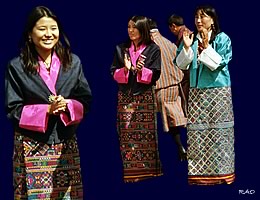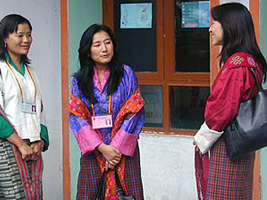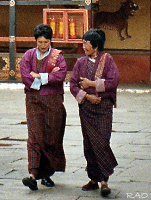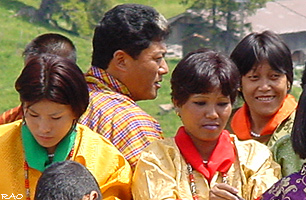| Bhutanese
Traditional Dresses |
 |
Bhutan Culture |
|
 |
Bhutan Culture |
|
|
 |
|
Wearing
a Kira
|
 |
 |
| HM Queen Ashi Tshering Pem Wangchuck and Princess Ashi Chimi Yangzom |
The kira is first draped around the back under the right arm. Wrap it around the
tront and fasten on your left shoulder with a koma (silver hook).
Fold it left to right across your front and then right to left. The remaining
cloth is gathered under the left arm and wrapped around the back to the
right shoulder, and fastened with a second koma. A kera is wrapped
around the waist to form a pouch.
The kaymeto (widthways border) is always worn at the back.
A toego (jacket) is often worn with the kira, and the sleeves of the wanju(blouse) can be folded back over the toego to form cuffs. |
|
 Wearing
a Rachu Wearing
a Rachu |
 |
| Women graduates practise wearing the rachu around the shoulders |
| Bhutanese
women will wear the rachu around the shoulder while showing reverence
to senior personalities and religious figures according to the Ministry
of Home and Cultural Affairs. At other times the rachu will be, as usual,
worn on the left shoulder.
"This
step is being taken to revive an age old tradition," said senior Driglam
Namzha Lopon, Tshering Penjor, who oriented 145 women graduates attending
the National Graduates Orientation Programme on the proper way of wearing
the rachu. |
|
 |
| According
to Tshering Penjor the rachu should be worn on the left shoulder
and while bowing down or showing respect one fold of the rachu should be
brought around to the right shoulder. He said that the rachu should be
worn the same way while prostating in temples and when receiving blessings.
|
|
 |
But the rachu will continue to be used the usual way wherever the rachu
is required to be worn.
Tshering
Penjor said that he did an intensive research on the particular tradition
by talking to 17 people who knew about the tradition which existed during
the time of the second King. The 17 interviewees aged between 72-88 years
were from Thimphu, Punakha, Trongsa, Bumthang, Paro and Pemagatshel.
Tshering
Penjor said that while it was not known when the particular tradition of
wearing the rachu around the shoulder disintegrated, research indicated
that it was widely practiced during the reign of the first and second Kings.
Some graduates said they liked the idea of draping the rachu around the
shoulder as it made them look more elegant and feminine. Others said that
it was more comfortable when bowing. Tshering Penjor said that the rachu
should be approximately 10 spans and the breadth should be one and a half
span of the person wearing it. "The adang rachu should be worn so that
while bowing the inside of the rachu will show patterns, and is not plain,"
he said.
The
kabney and rachu tradition was first brought into Bhutan by Guru Rinpoche
in the eight century according to Tshering Penjor. "Later in seventeenth
century Shabdrung Ngawang Namgyal assigned different coloured kabneys for
different designations," he said.
| Contributed
by KUENSEL, Bhutan's National Newspaper |
 |
| Information on Bhutan |
 |
|







